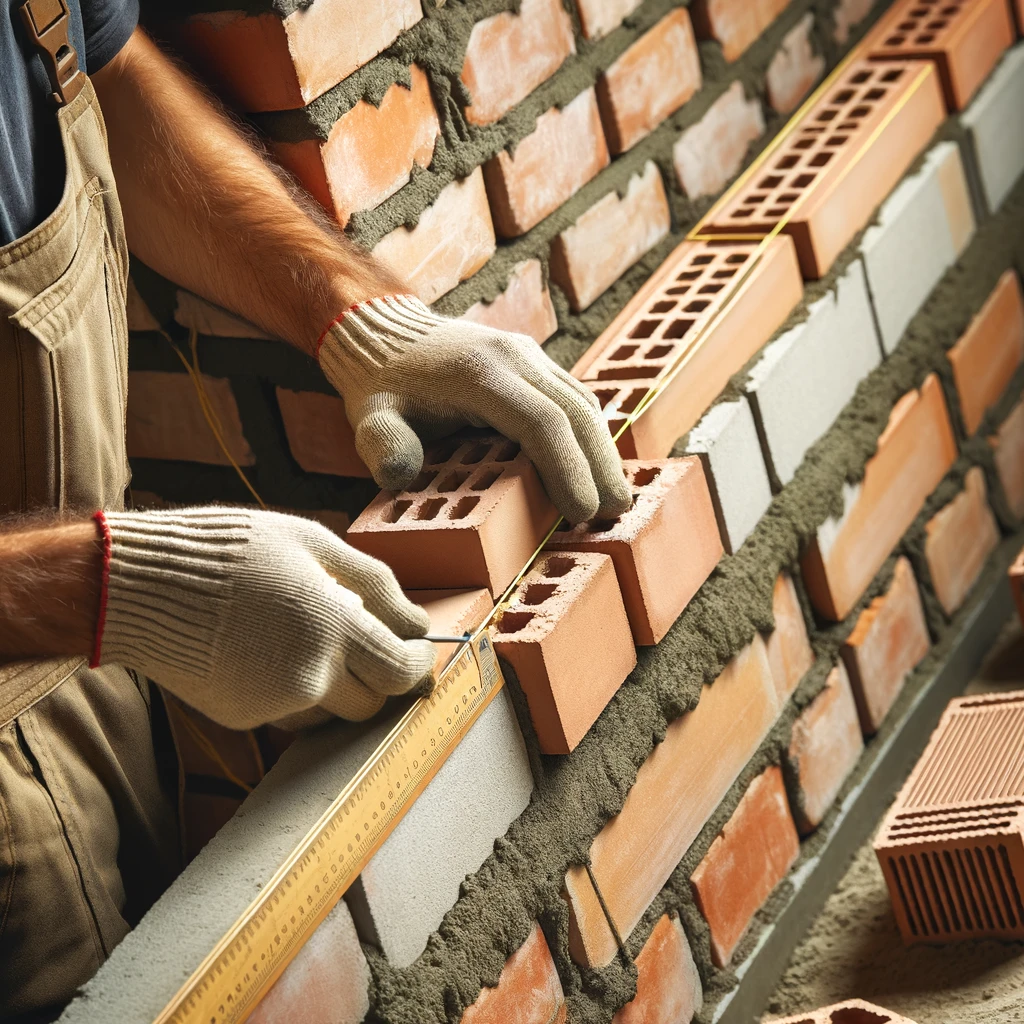Introduction To Mason’s Line
Can you imagine a building without straight, level walls?
I’m sure it’s not a pretty picture. The tool responsible for such accuracy might surprise you. It’s not some high-tech gadget, but a simple string!
In today’s article, we will explore the essential role of string in masonry and construction.
We’ll discuss the purpose of a mason’s line, its key uses, the different types of strings utilized, as well as how and why it’s used in construction. We’ll also provide some fun facts about string levels and their applications.
To quote architect Ludwig Mies van der Rohe, “God is in the details.”
So, let’s discuss the essential details that make masonry precision possible with a simple string.
Table of Contents
The Role of String in Masonry

Purpose of String in Masonry
In masonry, a string, often referred to as a mason’s line, is a vital tool used to ensure the accuracy and level of the structure. This straightforward yet important tool helps masons accomplish precise alignments, which is essential for the stability and aesthetic of the building.
Key Uses of Mason’s Line
- Alignment: Ensures bricks or blocks are laid in a straight line.
- Leveling: Helps maintain a consistent level across rows of bricks.
- Placement: Identifies the exact positioning for each brick or block.
Types of String Used
Different types of strings are used based on the specific requirements of the masonry project.
| Type of String | Material | Application |
|---|---|---|
| Mason’s Line | Nylon or Polyester | General-purpose leveling and alignment |
| Braided Mason Line | Braided Nylon | Heavy-duty projects with more tension |
How to Use Mason’s Line in Practice
- Setting Up: Attach the string to line blocks or line pins at both ends where you need to establish a straight line.
- Stretch Tightly: Ensure the string is taut between the two endpoints to avoid sagging.
- Check Regularly: Frequently check the string through a level or by eye to maintain accuracy.
The Essentials of Mason Line String
The Art of Masonry With String
The mason line string is not as simple as it seems at first glance. This high-strength string serves as the mason’s guide, leading the process of constructing a wall that is not just solid but also pleasing to the eye.
By creating a continuous guide, the mason string line reassures the mason of the accuracy and precision of their work, row after row, brick by brick.
Characteristics of Mason’s Line
Although mason lines appear simple, they carry features that make them essential to mason work. As such, the choice of mason string lines should be made with care based on their:
- Material: Often made from nylon or polyester, ensuring it can withstand wind and weather changes.
- Durability: Must withstand the consistent tension as bricks or blocks are aligned against them.
- Visibility: Usually brightly colored to increase visibility against the backdrop of similar-colored bricks or blocks.
Mason Line Maintenance
Despite its robust nature, taking care of the mason line is also important. Regular on-site practices should include:
- Cleaning: Regularly clean the line to remove accumulated dirt and maintain visibility.
- Checking for Abrasion: Continuous usage may lead to abrasions. Regular checks can help identify these early.
- Proper Storage: When not in use the string should be properly wound and stored to avoid tangles and wear.
Choosing the Right Mason Line
The chosen masonry line must suit the project at hand. Whether it is a small DIY home project or a large-scale construction project, the use of braided mason lines for larger tasks is a testament to its durability and strength.
It’s important to select a mason line that fits the bill in materials, durability, visibility, and application needs as per the project requirements.
Elevating Masonry Skills with Mason Line
Though the mason line string is a simple tool, it exemplifies the saying “simplicity is the ultimate sophistication”.
An adept understanding and usage of the mason line can truly elevate the quality of masonry work. The successful utilization of mason line string indicates a mason’s keen eye for precision, straightness, and level, which are the pillars of creating a structurally sound and aesthetically pleasing wall.
What is a String Line Used for in Construction?
Functionality of String Lines in General Construction
In addition to its critical role in masonry, a string line serves various purposes across multiple types of construction projects. String lines provide a visual guide for ensuring straightness and alignment, which are essential for structural integrity and accuracy in construction.
Broad Applications of String Line
Beyond masonry, the utility of string lines extends to several other construction tasks:
- Grading and Excavation: Used to mark levels for proper grading and excavation work.
- Foundation Layout: Critical in outlining the layout of a building’s foundation to ensure corners and walls are perfectly aligned.
- Formwork: Helps in setting up the formwork accurately, ensuring that concrete pours are uniformly level.
- Fencing: Important for laying out straight and aligned fences or boundary lines.
- Landscaping: Assists in creating straight lines for planting beds, walkways, and other landscape elements.
Different Types of String Lines for Construction
Depending on the task, different varieties of string lines are used. Each type comes with its own set of properties tailored to specific tasks:
| Type of String Line | Material | Application |
|---|---|---|
| Standard Mason Line | Nylon or Polyester | General alignment for brick and block laying |
| Braided Mason Line | Braided Nylon | High-tension projects needing more durability |
| Chalk Line | Cotton or Polyester with powdered chalk | Marking long straight lines on flat surfaces |
| Surveyor’s Line | Kevlar-reinforced Nylon | Long-distance, high-accuracy outdoor projects |
Simple Steps to Effectively Use a String Line
Implementing a string line in construction is straightforward, but requires precision:
- Setting Anchor Points: Secure anchor points using stakes, nails, or pins at each endpoint of your intended line.
- Stretching the Line: Extend the string line tightly between the anchor points to create a straight, taut line.
- Aligning and Leveling: Use levels or sighting methods to ensure the line is level and straight, adjusting your anchor points as needed.
- Continuous Checking: Regularly check the integrity and tension of the string line to avoid sagging, which can lead to misalignment.
Maintaining Your String Line
Proper care can extend the life of your string line and maintain its functionality:
- Storage: Always store the string line properly wound and in a dry location to prevent tangling and deterioration.
- Regular Inspection: Frequently inspect for fraying, cuts, or other signs of wear and replace as needed.
- Cleaning: Clean the line if it gathers dirt or other debris to maintain its visibility and strength.
For a more detailed explanation about how essential string lines can be for various construction tasks, check out this guide on using string lines for home building at Today’s Homeowner.
String Level in Masonry and Construction
What is a String Level Used For?
A string level is an important tool in construction and masonry. It is used to determine the level of a string line for various applications such as laying bricks, setting fence posts, or grading soil. Essentially, a string level ensures that the string being used as a guide is perfectly level, which in turn helps to achieve a level and accurate final product.
Key Advantages of Using a String Level
The utilization of a string level has several benefits that contribute to the efficiency and accuracy of construction tasks:
- Accuracy: Ensures that the string line is straight and level, which is crucial for structural integrity.
- Efficiency: Speeds up the process of setting levels over long distances compared to traditional levels.
- Versatility: Can be used in various construction tasks such as masonry, framing, fencing, and landscaping.
Types of String Levels
Different types of string levels are available to suit various construction needs. Each type of string level offers specific features to facilitate different tasks:
| Type of String Level | Material | Application |
|---|---|---|
| Standard String Level | Plastic | General construction and leveling tasks |
| Mini String Level | Aluminum or Plastic | Small-scale projects requiring precise leveling |
| Magnetic String Level | Plastic with Magnetic Edges | Projects involving metal frameworks or surfaces |
How to Use a String Level
Follow these simple steps to effectively use a string level in your construction projects:
- Secure the String: Set up your string line by securing it at both ends using stakes, nails, or line pins.
- Attach the String Level: Clip or attach the string level to the middle of the taut string line.
- Level the String: Adjust the tension or height of the string line until the bubble in the level is centered between the lines, indicating that the string is level.
- Continuous Adjustment: As you work, frequently check and adjust the string level to maintain accuracy.
Maintaining Your String Level
Proper maintenance of your string level ensures its longevity and continued accuracy:
- Clean Regularly: Wipe down the string level after use to remove dirt, dust, and debris.
- Check for Damage: Regularly inspect the level for cracks or damage and replace it if necessary.
- Proper Storage: Store the string level in a dry, safe place to prevent it from being damaged or lost.
For an additional overview and functionality of string levels in construction, you can explore this detailed guide by Bob Vila that explains their various uses and benefits in different construction scenarios.
Conclusion
The importance of string, specifically a mason’s line, cannot be overstated in the world of masonry.
From guidelines for straight lines and perfect leveling, it proves why simplicity can impact sophistication in construction. Trusty nylon or polyester mason’s lines offer general purpose alignment, whereas braided mason lines cater to heavy-duty tasks. Beyond masonry, string plays a useful role in landscaping, excavation, and other construction activities.
Irrespective of the type, these lines guarantee accuracy, efficiency, and versatility in construction projects, while a string level ensures the string guide remains accurately placed.
Remember to choose your line as per your project requirements and ensure regular checks and maintenance for longevity. Whether it is a humble home project or a massive construction site, respect the string.
Because it looks simple but gets the job done right every time.
Frequently Asked Questions – FAQs
What is a string line used for in construction?
A string line is used to ensure straightness and alignment in construction projects. It’s commonly used in masonry, foundation layout, fencing, and landscaping.
How does a string level work?
A string level is used with a string line to maintain a level line over a long distance. The bubble in the level indicates when the string is perfectly level.
What material is typically used for a mason’s line?
Mason’s lines are typically made from durable materials such as nylon or polyester. Braided nylon is used for heavy-duty projects.
How do you maintain a string line?
Maintaining a string line involves regular cleaning to remove accumulated dirt, checking for signs of abrasion, and proper storage when not in use to avoid tangles and wear.






